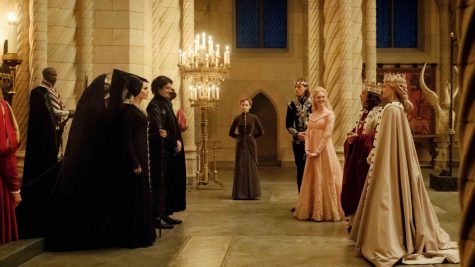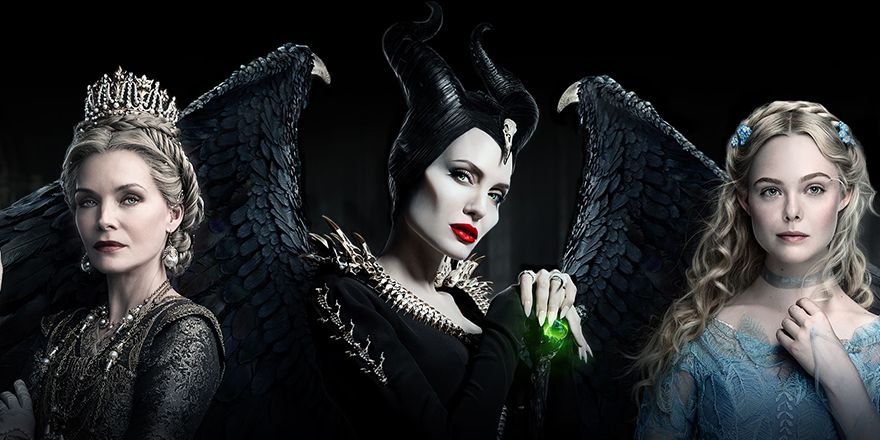Maleficent: Mistress of Evil – Return of the Cheekbones
The Evil Sorceress appears a second time in the sequel to Maleficent.
December 13, 2019
The most compelling part of Maleficent: Mistress of Evil is Angelia Jolie’s pitch-perfect portrayal of Maleficent, right down to the razor-sharp cheekbones. The film, directed by Joachim Rønning and released on October 18th, 2019, though entertaining, feels unoriginal and simplistic. Disney falls short in their attempt to create a new type of villain, eventually adhering to conventional stereotypes. The film, which runs a minute short of two hours, had just the right amount of suspense to keep me watching. However, the moments intended to be filled with the most apprehension were often overdone, resulting in several accidently humorous scenes.

Maleficent: Mistress of Evil begins with a proposal. Prince Phillip, prince of the Kingdom of Ulstead, is determined to marry Aurora, queen of the Moors, despite the ancient feud between their kingdoms. Hower, the queen of Ulstead, Queen Ingrith, has ulterior motives. She hopes to use her son’s love for Aurora to her advantage, to kill Maleficent once and for all. With the help of other dark fays, Maleficent tries to find a way to stop the evil queen before her entire species is eliminated. Throughout the film, the relationship between Aurora and her godmother, Maleficent, is focal.
Though the film is titled “Maleficent: Mistress of Evil”, Maleficent is most definitely not malevolent. As Peter Travers, film critic for Rolling Stones states, “… the 2014 live-action origin story took pains to show us how the fang-toothed villainess from Sleeping Beauty had reformed and grown to love Aurora, the human child she cursed and then raised as her own.” The retelling of the Sleeping Beauty story creates a more layered character of Maleficent. A character that is neither villain (though Maleficent occasionally loses her temper, it is clear she has a loving heart), nor hero (Maleficent doesn’t always choose to do the “right” thing) is refreshing to see in a disney film. The decision to add complex, emotional motives and real feelings to a disney villain had not been done before, and the different perspective is certainly a welcome change from the flat, one-dimensional, typical villain.

Maleficent seeks revenge on Queen Ingrith.
However, the “perspective of the villain” is not a completely original idea. The most obvious example of this is the musical Wicked, which premiered on Broadway in 2003. Wicked is a sort of prequel that tells the story of the Wizard of Oz, but from the Wicked Witches point of view. The Wicked Witch (AKA Elphaba) is shown with purpose and sentiment. The more complicated version of this character adds depth to the story. Still, Maleficent is not a very complex or deep film. It follows traditional stereotypes (with characters other than Maleficent) and adheres to basic, predictable plot twists. Although this makes for a generally enjoyable movie, many critics argue that its lack of depth, complexity, and originality make it unbearable.
Still, Maleficent is not a very complex or deep film. It follows traditional stereotypes (with characters other than Maleficent) and adheres to basic, predictable plot twists.
Maleficent: Mistress of Evil was, I’ll admit, entertaining. It had me rooting for the “good-guys” and eagerly awaiting the downfall of the “bad” ones. I apprehensively watched during suspenseful moments, and felt great satisfaction when the ending I had hoped for was delivered. The ending to the movie was a classic disney conclusion, a “happy ending”, if you will. Though it further exemplified the basicness and simplicity of the film, it was satisfying.
The computer-generated imagery (CGI) in Maleficent: Mistress of Evil was extremely realistic and helped immerse viewers into the world of the Moors. It also established a whimsical tone for the movie. The scenery in the Dark Fay’s cavern was truly breathtaking. The CGI not only affected the setting, but the action scenes as well. The animation applied to the fight scenes and transformations brought the film to life. The only downside I saw to the movies heavy reliance on CGI was the slightly creepy representation of Aurora’s three fairy godmothers (Knotgrass, Thistlewit and Flittle), which was uncannily realistic.

Overall, Maleficent: Mistress of Evil, was an engaging and satisfying film. Though some parts of it feel familiar, the creativity and contrast to other disney films, plus the incredible acting will make it worth your while.




